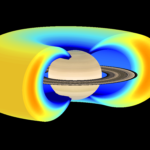Radiation belts of very high energy electrons and protons can form around some planets – at the Earth these large donut shaped regions in space are often called the Van Allen belts after James Van Allen. The extremely energetic particles in the belts are a hazard to both astronauts and spacecraft and understanding and predicting the ebb and flow of these particles is a challenging task.
At the Earth we now understand that waves in the electric and magnetic fields that pervade the space around a planet can interact with the electrons in the plasma there not only to decrease their energy and sometimes remove particles from the radiation belts, but also to significantly increase particle energy. This resonant wave-particle interaction process is very important at the Earth and we are now testing its effects at other planets to see if it is more widely applicable in the Solar System, and perhaps the Universe.
Specifically we will be looking at the radiation belts of the Earth, Jupiter and Saturn. This project will help to set new research goals for future spacecraft missions to the planets and develop computer models that will be of direct use to the space insurance, satellite construction and satellite service industries and leave a legacy of understanding that will last long after the completion of the project.
29 November, 2018
A team of international scientists from BAS, University of Iowa and GFZ German Research Centre for Geosciences has discovered a new method to explain how radiation belts are formed around …
8 August, 2018
Understanding of how Jupiter’s magnetic field interacts with its moons and with intense particle radiation.

